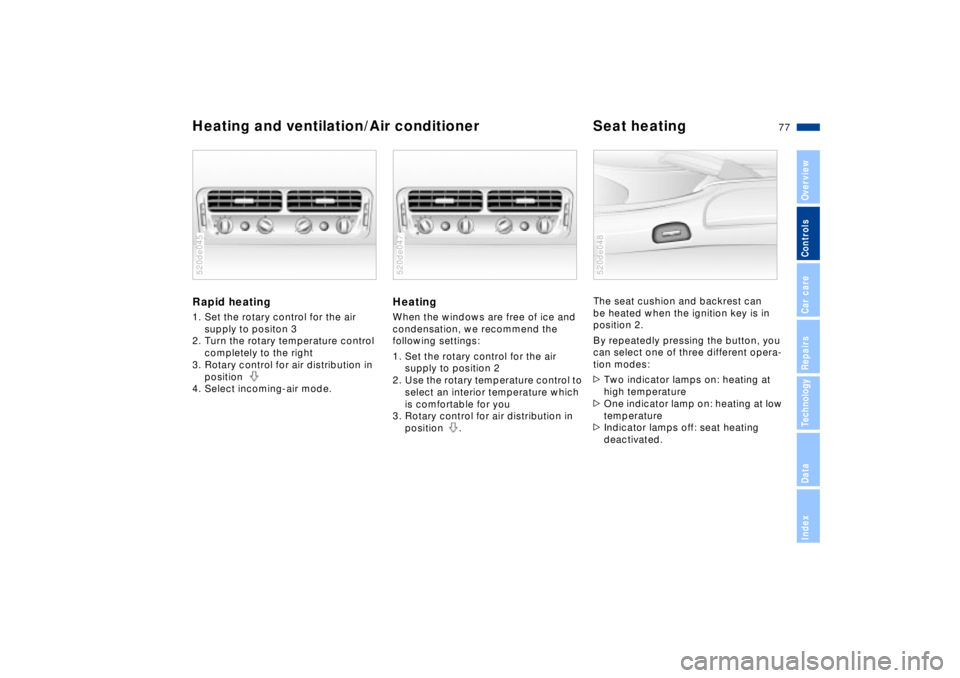2002 BMW Z8 CONVERTIBLE heating
[x] Cancel search: heatingPage 77 of 174

77n
IndexDataTechnologyRepairsCar careControlsOverview
Heating and ventilation/Air conditioner Seat heatingRapid heating 1. Set the rotary control for the air
supply to positon 3
2. Turn the rotary temperature control
completely to the right
3. Rotary control for air distribution in
position
4. Select incoming-air mode.520de045
HeatingWhen the windows are free of ice and
condensation, we recommend the
following settings:
1. Set the rotary control for the air
supply to position 2
2. Use the rotary temperature control to
select an interior temperature which
is comfortable for you
3. Rotary control for air distribution in
position .520de047
The seat cushion and backrest can
be heated when the ignition key is in
position 2.
By repeatedly pressing the button, you
can select one of three different opera-
tion modes:
>Two indicator lamps on: heating at
high temperature
>One indicator lamp on: heating at low
temperature
>Indicator lamps off: seat heating
deactivated.520de048
Page 87 of 174

87n
IndexDataTechnologyRepairsCar careControlsOverview
Brakes:
Do not rest your foot on the brake
pedal while driving. Even light but
consistent pressure on the brake pedal
could lead to high temperatures, brake
wear, and possibly, to brake system
failure.
Aquaplaning:
Reduce speed while driving on wet or
slushy roads, otherwise, a wedge of
water can form between the tires and
the road surface. This phenomenon is
referred to as "aquaplaning" or "hydro-
planing." It is characterized by a partial
or complete loss of contact between
the tires and the road surface. The ulti-
mate results are loss of steering and
braking control.
Driving through water:
When there is water on the roads, do
not drive in it if it is deeper than 1 ft
(30 cm), and even then, only at walking
speed, otherwise the vehicle can
sustain damage to the engine, the elec-
trical systems and the transmission.<
The catalytic converter reduces harmful
exhaust emissions.
It is designed for use with unleaded fuel
only. Even minute quantities of lead
would be enough to permanently
damage both the catalytic converter
and the system's oxygen sensor.
To ensure efficient, trouble-free engine
operation and to avoid potential
damage:
>Be sure to comply with the scheduled
maintenance requirements
>Fill the fuel tank well before it is empty
>Tow-start only when the engine is
cold. If you attempt to tow-start with
a warm engine, unburned residual
fuel could ignite on the way to the
catalytic converter and cause
damage. It is better to start the
vehicle with a battery charger or
assistance from another vehicle
>Avoid other situations where the fuel
is either not burned or burns incom-
pletely, such as engaging the starter
frequently or for extended periods, or
repeated start attempts in which the
engine does not start (stopping and
restarting an engine which is running
properly does not present a problem).
Never allow the engine to run with
any of the spark plug cables discon-
nected.Be sure to comply with the
instructions above to prevent
unburned fuel from reaching the cata-
lytic converter. Otherwise, there is the
danger of overheating and damage to
the catalytic converter.
Extreme temperatures are present with
the catalytic converter both on this and
every catalyst-equipped vehicle. Heat
shields are installed adjacent to some
sections of the exhaust system. Never
remove these shields; do not apply
undercoating to their surfaces. When
driving, standing at idle, and parking
the vehicle, take care to avoid contact
between the exhaust system and flam-
mable materials (grass, hay, leaves
etc.). Such contact could start a fire,
resulting in serious personal injury and
property damage.<
Driving notes Catalytic converter
Page 91 of 174

91n
IndexDataTechnologyRepairsCar careControlsOverview
Disc brakesDriving notesWhen driving in heavy rain and on wet
roads it is advisable to apply light pres-
sure to the brake pedal every few miles.
Monitor traffic conditions to ensure that
this maneuver does not pose a hazard
to you or to other road users. The heat
generated in this braking process helps
dry the pads and rotors
Maximum braking force is obtained
while the wheels are not locked, but
rather when they are still barely turning
immediately prior to locking. ABS main-
tains this state automatically. If the ABS
fails, you should revert to the staggered
braking technique (refer to page 93).
When descending steep hills and
extended grades, downshift to a gear
that will allow you to continue safely
with only a minimal amount of braking.
By minimizing the loads placed on the
brake system, this strategy helps
ensure that optimal brake system
response will remain available at all
times.
You can enhance the engine's braking
effect by downshifting, into first gear, if
necessary. Even if engine braking fails to slow the
vehicle sufficiently, you should still
make every effort to avoid prolonged
braking with continuous application of
low to moderate pressure at the pedal.
It is better to decelerate the vehicle by
applying a higher level of force at the
pedal (watch following traffic!) and then
subsequently pausing to allow the
brakes to cool briefly before starting on
your next braking cycle. By protecting
brake system components against
overheating, the cooling phases
afforded by this staggered, or intermit-
tent braking technique help maintain
consistent availability of optimal braking
response when it is needed.
Do not coast with the clutch pedal
depressed, the gear-shift lever in
neutral, or, above all, with the engine
off; otherwise, the engine will provide
no braking effect if the transmission is
in neutral, and there is no braking or
steering power assist if the engine is
not running. Never allow floor mats,
carpets or any other objects to obstruct
the accelerator, clutch or brake pedals
and pose a safety hazard by reducing
their available travel range.<
Page 100 of 174

100n
Avoid overloading the vehicle so
that the permitted load on the tires
is not exceeded. Overloading can lead
to overheating and increases the rate at
which damage develops inside the
tires. You could have a blowout as a
result.
Unusual vibrations encountered during
normal vehicle operation can indicate a
flat tire or some other vehicle defect, as
can variations in normal vehicle
response, such as a pronounced
tendency to pull to the left or right.
Should this occur, respond by immedi-
ately reducing your speed. Proceed
carefully to the nearest BMW center or
professional tire center, or have the
vehicle towed in to have it and its tires
inspected.
Tire damage can endanger the lives of
both the vehicle occupants and other
road users.<
To maintain good handling and vehicle
response, use only tires of a single
tread configuration from a single manu-
facturer. BMW tests and approves
wheel and tire combinations. Refer to
page 104.DOT Quality GradesTread wear
Traction AA A B C
Temperature A B C
All passenger vehicle tires
must conform to Federal Safety
Requirements in addition to these
grades.
when tested under controlled condi-
tions on a specified government test
course.
For example, a tire graded 150 would
wear one and one-half (1g) times as
well on the government course as a tire
graded 100. The relative performance
of tires depends upon the actual condi-
tions of their use, however, and may
depart significantly from the norm due
to variations in driving habits, service
practices and differences in road char-
acteristics and climate.TractionThe traction grades, from highest to
lowest, are AA, A, B and C.
Those grades represent the tire's ability
to stop on wet pavement as measured
under controlled conditions on speci-
fied government test surfaces of
asphalt and concrete. A tire marked C
may have poor traction performance.
The traction grade assigned to
this tire is based on straight-
ahead braking traction tests, and does
not include acceleration, cornering,
aquaplaning, or peak traction charac-
teristics.<
Tire condition Tire replacement
Page 168 of 174

Everything from A to ZFFailure to start146t
Fault in ABS89
Filler cap cover25
Filling capacities161
Filling the washer
reservoir161
First-aid kit24
Fittings, tow-starting and
towing146t
Flashlight79
Flat tire137t
Flat Tire Monitor67
Fog lamp, bulb
replacement133t
"Follow me home"
lamps49, 69
Footbrake90
Footwell lamps71
bulb replacement134t
Front seat adjustment45
Frost protection,
radiator113
Fuel26
gauge62
indicator62
quality26
Fuel filler door
manual release after
electrical fault142tFuel injection system158
Fuel tank capacity161
Fuses140
GGasoline26
quality26
Glove compartment78
bulb replacement135t
Gross vehicle weight160HHand lamp79
Handbrake57
Hands-free system81
Hardtop96
Hazard warning
flashers24t
Hazard warning
triangle24t
Head restraint46
Headlamp covers,
care117t, 131t
Headlamp flasher70
Headlamp washer
system60, 110, 161
Headlamps70
Headlight glare in rearview
mirror48
Heated mirrors48
Heated seats77
Heating and ventilation72Heating, rapid77
Heavy loads83
Height159
High beams23, 58, 70
Holder for beverage
cans80
Hood release105t
Horn17
Hydraulic system88, 92
IIdentification, tires102
Ignition keys30
Ignition lock55
Imprint4
Incoming-air mode74
Indicator lamps20
Inflation pressure26t, 99
monitoring67
INSPECTION63
Instrument cluster18
Instrument panel lighting69
Instruments18
Interaxle tire rotation101
Interface socket for Onboard
Diagnostic126
Interference
cellular phone94
radio reception95
Interior lamps34, 71
bulb replacement135t
remote control34Interior motion sensor39
deactivating34
Interior rearview mirror with
automatic
dimmer48, 154
Intermittent mode of wiper
system59
JJump-starting145KKey Memory49
Key with remote control30
Keys30LLamps and bulbs131t
Leather care122
Length159
License plate lamp, bulb
replacement133t
Light switch69
Light-alloy wheels104
Lighter82
LIGHTS ON warning69
Loading83
Lock deicer92
Louvers72
Low beam headlamps69
Page 169 of 174

Everything from A to Z
169n
IndexDataTechnologyRepairsCar careControlsOverview
Low traction road
surfaces93
Luggage compartment37
bulb replacement136t
capacity160
remote control35
Luggage compartment
lid37
emergency release37t
emergency release from
luggage compartment's
interior38MM+S tires103
Maintenance63, 116
Malfunction, ABS89
Manual transmission58
Map lamps71
Microfilter75
MIR (Multi-Information
Radio)64
Mirrors48
Mobile phones81, 94
Modifications,
technical6, 125
Multi-Information Radio
(MIR)64
NNavigation system, refer to
the radio Owner's Manual
Neckrest46
Neon lamps131OOBD interface socket126
Odometer62
Oil
additives111
consumption111
fill capacity161
quality112
specifications112
viscosity112
Oil change intervals, see the
Service and Warranty
Information Booklet (US
models) or the Warranty
and Service Guide Booklet
(Canadian models)
Oil dipstick111
Oil filter change161
Oil level
check111
indicator lamp21
Oil pressure
indicator lamp20
OILSERVICE63
Onboard tool kit130tOpening and closing
from the inside36
from the outside32
Operation in winter92
Outlets, ventilation72
Outside temperature
display64
PPaint, care119
Paintwork
minor repairs120
waxing120
Parking brake57
Parking lamps69, 70
bulb replacment132t
Parking, winter94
Performance158
Phone, refer to cellular
phone94
"Please fasten your safety
belt" warning lamp21
Pocket flashlight79
Pollen75
Power steering94
Power windows40
Pressure, tires26t, 99
monitoring67
RRadio64, 94
refer also to the radio
Owner's Manual
Radio reception95, 151
Rapid heating77
Reading lamps71
Rear fog lamp70
bulb replacement133t
Rear window
defroster60, 75
Rearview mirror48
Recirculated-air mode74
Refill washer
reservoir110t
Refueling25
Remaining fuel indicator62
Remote control33
Removing condensation
from the windows75t
Removing the vehicle from
storage124
Replacement keys30
Replacing fuses140t
Replacing lamps and
bulbs131t
Replacing windshield wiper
blades130t
Replenish washer
fluid110t
Reporting Safety Defects7
Page 170 of 174

Everything from A to ZRestraint systems53
Return used
batteries140t
Reverse17, 58
Roof load capacity160
Rotating the tires101
Rubber parts93SSafety belt tensioners153
Safety belts50
Safety buttons36
Safety tires99
Seat adjustment45
Seat heating77
Securing cargo83
Self-defrosting mirrors48
Service Interval
Display63, 116
Shelves78, 79
Should131t
Side airbags51
Side marker lamps69
bulb
replacment131t, 132t
Skid control94
Slippery roads93
Snow chains93, 103, 104
Socket82
for flashlights82
for power supplies82
for vacuum cleaners82Sound system, refer to the
separate Owner's Manual
Spare key30
Spark plugs162
Speaker81
Specified engine oil112
Speedometer18
Starting56
problems87t, 145
Steel wheels104
Steering94
Steering wheel lock55
Stopping the vehicle57
Storage areas78, 79
Storing your vehicle124
Stroke158
Summer tires102
Switching off the engine57
Switching off the interior
motion sensor39t
Switching off the tilt alarm
sensor39t
Symbols4, 138
TTachometer62
Tail lamps132
bulb replacment132t
Tank capacity161
Technical data158
Technical
modifications6, 125Telephone81
Temperature display
outside temperature64
Temperature gauge
engine coolant63
Temperature
selection74, 75
Tilt alarm34
Tilt alarm sensor39
Tire codes102
Tire damage99t
Tire inflation
pressure26, 99
Tire pressure monitor67
Tire replacement100, 101
Tire rotation101
Tire specifications104
Tire tread99
Tools130t
Torque158
Tow fittings146t
Towing the vehicle146t
Tow-starting146t
Track159
Traction Control System
refer to DSC65
Transmission58
Transmitter key30
Tread depth, tires99
Trip odometer62
Trunk lid, refer to luggage
compartment lid37Turn signal indicator23, 59
Turning circle159
UUniform Tire Quality
Grading101
Unusually high steering
effort20, 94
Use antifreeze114t
radiator114t
Used batteries,
disposal140tVVacuum cleaner82
Vehicle battery138, 162
Vehicle care
exterior119
interior121
Vehicle equipment
options and accessories5
Vehicle Identification
Number (VIN)115
Vehicle immobilizer31
Vehicle painting119
Vehicle storage124
Vehicle weight160
Vehicle, starting56
Vehicle, stopping57
Ventilation72
draft-free75
Vinyl upholstery, care121